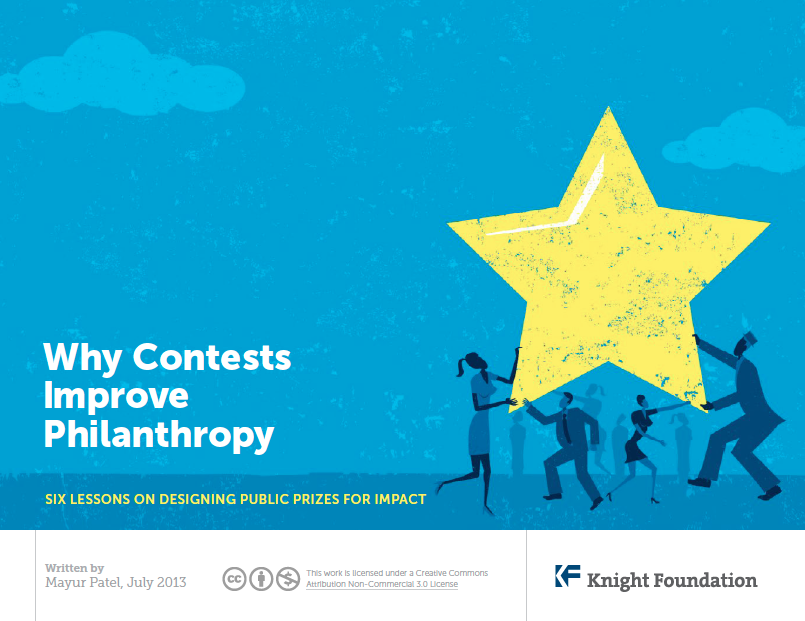Related Link
“Why Contests Improve Philanthropy: Six Lessons on Designing Public Prizes for Impact” by Mayur Patel and Sonal Shah
Knight Foundation has supported nearly a dozen open contests, reviewed almost 25,000 applications and chosen more than 400 winning ideas. We’ve learned a lot from this experience about how good contests work, what they can do, and what the challenges are. We’ve captured this in an array of materials that share these lessons.
Today with the launch of a new report, “Why Contests Improve Philanthropy: Six Lessons on Designing Public Prizes for Impact,” we’ve brought together our experiences in managing contests across all our program areas: journalism and media innovation, arts and communities. We hope this will serve as an invitation to others to consider how contests, when appropriate, might deepen the work they already do, broaden their definition of philanthropic giving and amplify their impact.
Our contest work started with the launch of the Knight News Challenge in 2007. The digital age had turned communications on its head, and we needed a way to respond. The contest enriched our journalism program’s traditional network of blue-chip educators and newsrooms and put a spotlight on an energetic community of emerging innovators, software engineers, designers and media entrepreneurs. It also allowed us to leverage technology—as a powerful tool to open up our giving.
All of our programs have now used contests to uncover new trends, widen their networks and support bold new ideas. In total, we’ve granted more than $75 million to experimental arts projects, resident-led neighborhood improvements, tech startups and data applications. Our support has gone to individuals, nonprofits and commercial enterprises.
Along the way, we’ve reviewed the effectiveness of individual contests. We’ve looked at the progress winners have made, refinements to how we run our processes and the issues we focus on. One thing stood out for us: Contests make up less than 20 percent of our grant-making, but they changed how we work as a foundation and reshaped our traditional programs. They helped create a “safe zone” for experimentation that has influenced other areas of our grant making. It’s challenged our routines and entrenched behaviors.
Through contests we’ve increased opportunities for people to participate in our work and in their communities. Contests exposed our foundation to a host of new talent and creativity from different disciplines and brought in many winners who otherwise would not have applied for a traditional grant. The applications we’ve received have helped put a spotlight on emerging trends and provided us with feedback to improve how we connect with our communities.
In the coming weeks we will explore the benefits of prizes in each of our program areas in a special blog series dedicated to contests. The series will draw out some of the main lessons in our latest report and explore the evolution of our work, so follow along for more insights.
We’re not alone in our commitment to contests. We see stellar work being done by others, including among others the X-Prize Foundation, Case Foundation, Bloomberg Philanthropies, MacArthur Foundation, the Robert Wood Johnson Foundation and the Rockefeller Foundation. Like many of these organizations, Knight Foundation sees lasting opportunities in contests. They are an effective tool helping us – and helping others – create social change.
Reports on our contests:
- Six Lessons on Designing Public Prizes for Impact
- Knight News Challenge Interim Evaluations: 2007-2008 winners, 2009 winners, andOverview of media innovation community
- A review of the media, information and communication contests landscape
- Knight Arts Challenge Interim Evaluation: Building the Arts in Miami
- Knight Community Information Challenge: Case Studies on Winning Projects, Overview on Partnerships Developed, Summary of Initiative Progress
Mayur Patel, vice president of Strategy and Assessment at Knight Foundation
